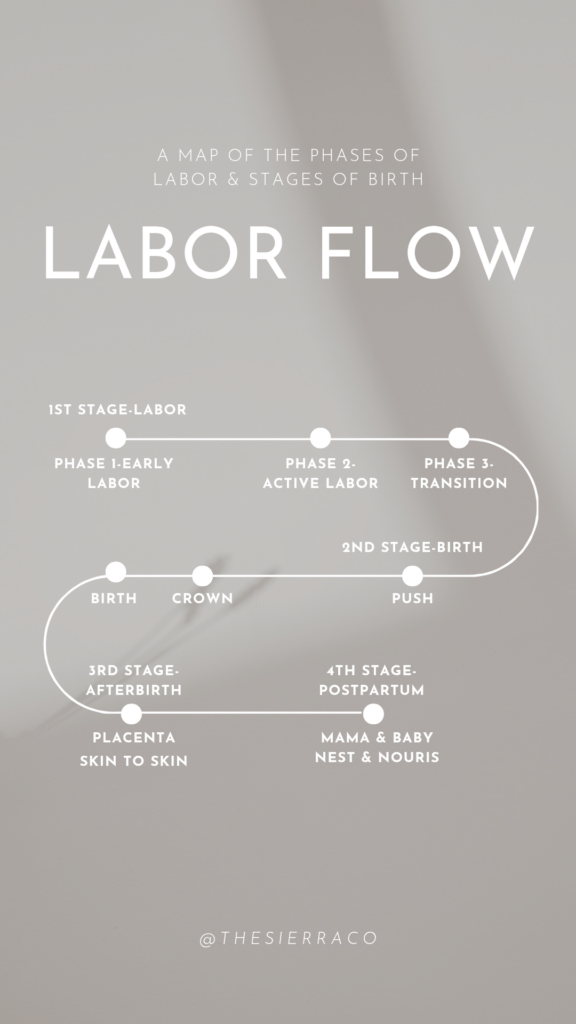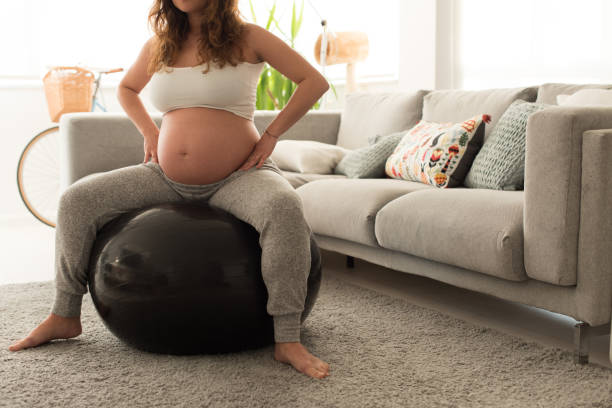the blog
Natural Birth & Female Health

Whether you are in your first trimester or third or possibly even in labor, investing time into learning the early signs of labor can offer peace of mind but also deepen the connection the mind-body connection, support the reclamation of birth autonomy and help facilitate a smooth transition into birth.
Understand the Early Signs of Labor
1 You want to confirm that labor has in fact begun by understanding the early signs of labor, how to recognize them and what they mean.
2 Communicate with your support team, or birth team, by giving them updates about what you’re experiencing.
3 Once you know you’re in early labor you’ll want to support your labor progress without over exerting yourself, Its a balance. You want to prevent complications like maternal exhaustion or painful contractions by following these early labor tips to confidently know what to do when labor starts.
Here are the 7 Early Labor Signs
1 Nesting
2 Hormone changes, changes in energy, mood, sleep patterns, bowel movements, vaginal discharge. Don’t disregard this sign.
3 Bloody show
4 Releasing your cervical cap
5 Regular contraction pattern, keyword ‘regular’, irregular contractions might be a sign that labor is on the horizon, but a regular contraction pattern is a sign that labor has started
6 Water breaking
7 Intuitive sense
They are not in chronological order. First, birth is outside of time, and second, you may experience a few at a time or several unfolding at once. Keep in mind that you may not experience all of these signs. Each labor is unique.
A quick little map of The Four Stages of Birth

Learn more about each stage of labor here
It is important to understand that early labor is usually the longest phase of labor.
So while you might be having signs that labor has started, it might not be time to call your birth team over or head into the hospital if you’re planning an Out-of-Home birth.
Related: What to Do When Labor Starts? Avoid Making The Common Mistakes and Do This Instead
Recognizing that you’re in labor will help you keep your support team updated and give them valuable information on what your body is doing and how baby is presenting in the womb.
The Signs of Early Labor
Uno-Nesting
A very real thing! Either your to do list has finally called your attention as your due window draws near or you wake up with the motivation, no… the Inspiration, to very suddenly, clean your entire house or my favorite-take on a massive project.
Why Do Women Nest?
Nesting is the biological instinct to find a safe space to birth and prepare this safe space for comfort, security, warmth, and other survival needs like food, water, fire wood, ect.
In todays society, this scene takes place in our homes. Women will often turn towards tasks that involve working with their hands, a practice that activates flow state.
Flow state is a state that activates our theta brainwaves where creativity flows, healing takes place and identity is formed as neuropathways are created.
Flow state puts us in an almost meditative flow as we fold our laundry, wash the dishes, organize baby clothes or decide we need to paint the walls right then and there.
Our brainwaves shift from Alpha to Theta brainwaves in active labor, when we surrender to a rhythmic pattern, engaging our primal brain. It is beneficial for hormone balance and supports a smooth, safe labor.
Note: Obsessive behavior, stress or anxiety are not the same thing as nesting. Mamas experiencing those signs need support. Call in your community and/or reach out to someone you trust and that is qualified to hold space for you.
Nesting, when energy is channeled mindfully, can support hormones and prepare you for birth and motherhood.
Hormones

Our hormones support a regular contraction pattern and hormones support the softening and stretching of our smooth muscles, our cervix, our arteries, our ligaments, especially around the pelvic bowl.
This softening is why women can expand and birth in ways they otherwise wouldn’t be able to outside of birth and pregnancy.
But that same hormone is responsible for changes in blood pressure, blood sugar levels, metabolism slowing, lower back and hip discomfort and changes in bowel movements.
FUN. I know…you’re almost there.
You might be experiencing hormone changes if you’re expressing these common phrases:
“I feel an ache around my hips,”
“I feel a lot of back discomfort”
“I couldn’t sleep last night”
“I feel especially tired today”
“I just have to get these things done today!”
“My bowel movements have changed”
“I’m feeling menstrual like cramps in my lower belly”
“I’m seeing bloody show”
“My appetite has changed”
“My sleep has changed”
Bloody Show
Blood show is a bit of blood coming from your cervix. Hormones increase the vasculature of your cervix, softening and ripening the cervix making it stretchier but also friable.
The tissues are full of blood and when the cervix is stimulated by baby’s head or during a vaginal exam or cervical massage or simply as it stretches and opens, the capillaries around your cervix release a bit of blood, just enough to tinge your intimates or toilet paper.
*While bloody show is a light spotting and is normal, bleeding heavily is not and you should reach out to your birth team if you’re experiencing bleeding.
Cervical Cap
Bloody show and the release of your cervical cap are both indications of cervical changes.
The release of the cervical cap can sometimes be confused with increased discharge or rupture of membranes (your water breaking).
How to know if your water broke?
…continue reading or the difference and if you think you’re water broke, reach out to your birth team.
The cervical cap keeps the womb closed and sterile to the external environment. It is a sticky, stretchy consistency, white, cream or clear in transparency sometimes white, yellow, brown and red in color.
It is the mucus plug that protects your womb and your baby. It can come out all at once or little by little.
Your cervix can release your cervical cap days before labor or during labor. Celebrate bloody show and the release of your cervical cap as changes in your cervix!
Contraction Pattern
The muscles contracting around the uterus start as early as 20 weeks. Most women begin to perceive these contractions in the third trimester. The difference between these contractions that tone the uterus during pregnancy leading up to labor and the contractions at the onset of labor is a regular contraction pattern.
Irregular contractions can be a sign that labor is on the horizon, but a regular contraction pattern that is in a consistent and frequent pattern and doesn’t go away is a sign of early labor.
Contraction patterns can vary from woman to woman and they are affected by both physical and emotional stress. The uterine muscle contractions are regulated by hormones like oxytocin and progesterone. When you are in a stressful state like tired, hungry, afraid, anxious, overwhelmed as a few examples, your body released hormones that slow down or prohibit a regular contraction pattern.
Stress can stop a labor from starting and prolong your pregnancy. Stress in labor can affect efficacy of contractions making them short, frequent and painful or long, irregular and ineffective further prolonging your labor.
This is a biological instinct. Your body doesn’t want to birth a baby in a stressful environment.
Related Post: The Stages of Labor: Early, Active, and Transition Phases of Labor
Water Breaking
Your water can break before regular contractions, during labor or not at all.
Your water doesn’t have to break for labor to start or continue and even if it does break, it isn’t actually a sign of labor.
Technically…don’t need to rupture your membranes (break your water) to have a baby.
If and when your water breaks, the amniotic fluid can gush out in high volume or leak out slowly. This can depend on where the amniotic sac ruptured, know as a high leak or a low leak.
The position of your baby can also allow or obstruct the flow of amniotic fluid past the cervix.
It is normal to experience leaking every time your abdominal or uterine muscles contract either when you change positions or have a contraction.
It is important to note what time your water broke, what color the fluid is, and if baby is still active.
How to Know if My Water Broke?
A contraction of your pelvic floor muscles will stop the flow of urine but not the leaking of amniotic fluid.
Excess vaginal discharge can be thin and watery and difficult to discern from amniotic fluid. Amniotic will continue to leak with contractions or changes in position.
If think you’re water has broken, reach out to your birth team for support and next steps.
You may decide to confirm that your water broke with pH or litmus paper (semen and evening primrose oil will give you a false positive) or with a fern test.
Yes, like the plant-a fern test is the collection of fluid taken from the opening of the cervix. The sample is placed on a glass slide and viewed under a microscope.
As the sample dries it crystalizes in the shape of the branches of a fern! It is beautiful and Def ask you provider to capture a photo of your fern test.

If and when you water breaks make sure to hydrate well, avoid vaginal exams as much as possible and supplement your immune system to avoid infection.
Intuitive Sense
Some women have a deep knowing as they meet their labor horizon, an intuitive sense that labor will begin soon and they are about to begin their journey to birthing and meeting their baby.
Birth is an opportunity to connect to your inner voice.
All the layers and masks dissolve away, exposing your most raw, primal, genuine self.
Pregnancy leading up to birth is a time to deepen your mind-body awareness and your connection to your intuition. This will prepare you for birth and help you drop into that awareness in labor where your inner voice will guide you as you navigate the stages of labor and the intensity of birth.
You can practice this mind-body connection now, whether you are still pregnant or you have started experiencing signs of labor.
Breathwork as simple as a few deep breaths can ground you and bring you back into your body.
Ok so What if I am in labor? What do I do when my labor starts?
Related: What to do When Labor Starts? Avoid Making this Common Mistake and Do this Instead
Labor unfolds differently for each woman and each pregnancy
Some women drop into labor suddenly with regular contractions every 3 minutes while for others it’s a slow gradual process. For some their water breaks while for others it may never rupture.
Your labor journey is affected by your physical and emotional well being, your lifestyle and your life experience-yes your past trauma can affect your labor.
Related: How to Have a Smooth, Safe Labor
Still not sure if you’re in labor?
DM me! Because I am on call for birth 24/7 I am used to receiving questions about labor at all hours.
The last thing I want for you is to be combing through Google midst labor, when you can get clarity as soon as possible and focus on the journey instead of the ‘what ifs’
or explore tools like Breath and body work
RELATED: HOW TO USE INTENTIONAL BREATHWORK IN BIRTH
Send me your questions or DM me to set up a free consult @thesierraco